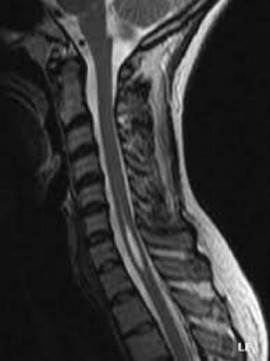Estimated prevalence at 8.4/100,000. One or more cavities (syrinx) are present within the spinal cord. They are filled with cerebrospinal fluid (CSF) and their surface is made of glial cells. The causes of secondary syringomyelia are well known while the cause of the much rarer idiopathic form is still unknown. There are few familial cases.
The secondary syringomyelias include:
1) the so-called hydrodynamic or communicating syringomyelias, caused by blockade of the circulation of cerebrospinal fluid at the junction of the ventricular and extraventricular compartments (ependymal canal). They are associated to Chiari abnormality (majority of cases); basilar impression or Dandy Walker malformation
2) the so-called nonhydrodynamic or noncommunicating syringomyelias (independent from the flow of CSF), result from the formation of a fluid cavity within the spinal cord following trauma, tumor, infection or vascular injury; the extracanalicular syringomyelias are not in communication with the ependymal canal nor the 4th ventricle.
Although syringomyelia can lead to an interruption of nerve connexions in the spinal cord with ensuing neurological deficits, 50% of patients (all types of syringomyelias) present no discomfort or only minor disability. In symptomatic patients, symptoms are rare before adolescence. These are usually pain (prickly sensations, shooting pains) and sensory disturbances (complete or partial Brown Sequard syndrome with contralateral thermoanalgesia, or complete absence of sensation with mutilating arthropathy or increased sensitivity to stimuli). Motor symptoms, of varying severity, generally vary from weakness or a localized amyotrophy to spasticity or even a loss of autonomy. Disorders of the urinary system and the sexual function may also be present. The management consists in long-term follow-up and/or surgery in case of progressive neurological deterioration.

The type of intervention is determined by the type and cause of the syrinx. in case of idiopathic syringomyelia, a direct derivation of the cavity into the subarachnoid space or into the pleural or peritoneal cavity, represents the only therapeutic option. in case of secondary form, treatment is based on the correction of the underlying cause. in case of post-traumatic syringomyelia due to a compression of the spinal cord, the reconstruction of the vertebral canal seems to give similar results. The prognosis is worse in case where the only surgical option is the direct derivation of the syrinx, since it often results in neurological deficits and recurrences.
Anesthetic implications:
according to the neurological deficit and its cause; in principle, maneuvers that can increase pressure in the CSF have to be avoided: coughing, Valsalva maneuver, perimedullar injection of a local anesthetic solution. Non-invasive monitoring of intracranial pressure (measurement of the external diameter of the optic nerve by ultrasound) and cerebral flow (velocity with transcranial doppler). However, cases of C-section under general, spinal, or epidural anesthesia as well as labour under epidural analgesia have been reported without complications.
References :
- Garvey GO, Wasade VS, Murphy KE, Balki M.
Anesthetic and obstetric management of syringomyelia during labor and delivery : a case series and systematic review.
Anesth Analg 2017 ; 125 : 913-24. - Soued M, Le Gouez A, Mercier FJ.
Anesthetic management of a patient with Arnold Chiari malformation and syringomyelia during laparoscopic surgery with neurologic monitoring: a case report.
A&A Practice 2025;19:e01908
Updated: February 2025